Photographs: Handout/Kyodo/Reuters
Japanese government on Monday blasted the operator of the crippled Fukushima nuclear plant for its "absolutely unacceptable" mistake of giving an extremely high radiation reading, as engineers battled to contain the country's worst atomic crisis.
The operator, Tokyo Electric Power Company, was criticised by Chief Cabinet Secretary Yukio Edono for describing the radiation levels as 10 million times higher than normal in water leaking from the no. 2 reactor's turbine building, before correcting the figure to 100,000 times.
"Considering the fact that the monitoring of radioactivity is a major condition to ensure safety, this kind of mistake is absolutely unacceptable," Edano said, more than two weeks after the monster magnitude-9 quake and tsunami struck Japan's northeast leaving nearly 30,000 people dead or unaccounted for.
Please ..
'The number is not credible. We are very sorry'
Image: A handout from Japan Ground Self-Defence Force shows no. 4 reactor at Fukushima Daiichi Nuclear Power PlantPhotographs: Handout/Kyodo/Reuters
As efforts continued to remove highly radioactive water from the plant, he said he has strongly instructed TEPCO to avoid the release of erroneous data on radiation leaks.
Edano said radiation analysis served as the basis for ensuring safety at the plant, where workers were struggling to safely cool the reactors and other machinery.
TEPCO on Sunday apologised for the "mistake" and said a worker who took the reading in a part of no. 2 reactor's cooling system had no time to confirm with a second reading because the radiation level was so high that he had to leave the area.
"The number is not credible. We are very sorry," TEPCO spokesman Takashi Kurita said.
'19 workers have been exposed to radiation'
Image: A woman is silhouetted as she is tested for possible nuclear radiation at an evacuation centre in FukushimaPhotographs: Kim Kyung-Hoon/Reuters
Engineers were trying to restore the power station's crippled cooling functions, while high radioactive concentrations were again detected in the nearby seawater.
Edano said the highly radioactive water found at the basement of the no 2 reactor's turbine building is "believed to have temporarily had contact with fuel rods (in the reactor's core) that have partially melted."
So far, 19 workers have been exposed to radiation exceeding 100 millisieverts at the plant, TEPCO said.
Exposure to 100 millisieverts is the legal limit for nuclear plant workers dealing with an emergency, but the limit has been raised to 250 millisieverts during the ongoing crisis, the worst Japan has seen, at the facility located some 220 km northeast of Tokyo.
'Highly radioactive water in vessel could have directly leaked'
Image: A man walks past a boat that was swept ashore after the March 11 earthquake and tsunami, at Otsu port in Kitaibaraki, Ibaraki prefecturePhotographs: Issei Kato/Reuters
Among the 19, three received treatment at a radiation research centre in Chiba prefecture after they were exposed to radiation of 173-180 millisieverts on Thursday.
They were discharged on Monday, with officials of the centre saying the exposure had not affected their health.
The Nuclear Safety Commission of Japan said in its report to Prime Minister Naoto Kan that highly radioactive water in the no. 2 reactor's containment vessel could have directly leaked, raising concerns that polluted water could spread to the building's underground and to the sea.
'Radioactive materials would be significantly diluted'
Image: Handout photo from the Japan's Nuclear and Industrial Safety Agency shows Tokyo Electric Power Co. workers recording the status of instruments in a control room at the Fukushima Daiichi Nuclear Power PlantPhotographs: Handout/Kyodo/Reuters
Hidehiko Nishiyama, a spokesperson for the nuclear agency, said it is highly likely that the polluted water detected near the no. 5-6 reactors of the plant spread from the sea area near the no. 1-4 reactors along the coastline.
Nishiyama said there were no health concerns so far because fishing was not being conducted in the evacuation-designated area within 20 km of the plant and radioactive materials would be "significantly diluted" by the time they would be consumed by marine species and then by people.
'Quake at Miyagi prefecture won't affect work at nuclear plant'
Image: Police officers wearing protective suits search for victims of the earthquake and a tsunami in Fukushima prefecture in Minamisoma City, about 30km north of the crippled Fukushima Daiichi Nuclear Power StationPhotographs: Yomiuri Shimbun/Reuters
Since Sunday, TEPCO has been trying to move the radioactive water in the basement of the no. 1 reactor's turbine building to a tank in the unit by using three pumps.
But the operator was yet to start such work at the remaining three reactor buildings due to difficulties in accommodating the polluted water, according to the nuclear agency.
Earlier in the day, a strong earthquake with a preliminary magnitude of 6.5 jolted Miyagi prefecture and its vicinity in northeastern Japan, but TEPCO said the tremor was unlikely to affect work to restore the plant's key cooling functions.
'There is a big risk at the moment'
Image: Efforts to spray water into the no. 4 reactor at the Fukushima Daiichi Nuclear Power PlantPhotographs: Handout/Reuters
The government, meanwhile, urged residents of the evacuation-designated area within 20 km of the troubled Fukushima nuclear plant not to return for the time being due to the health risks.
"There is a big risk (to human health because of contamination) at the moment," Edano said, asserting that the residents should not enter that evacuation zone until after the government gave the go ahead to do so.
His remarks came amid reports that the locals were briefly returning without permission to their homes to collect belongings.
The government also faced the daunting task of clearing the rubble from the hard-hit areas in northeastern and eastern Japan, with Miyagi prefecture Governor Yoshihiro Murai saying that it would be roughly 15-18 million tonnes in his region.

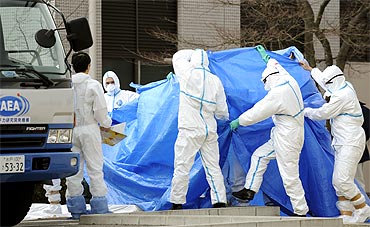
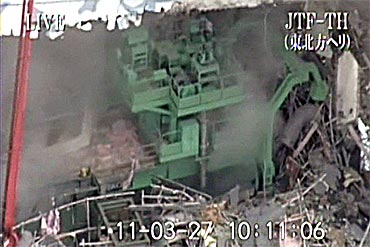
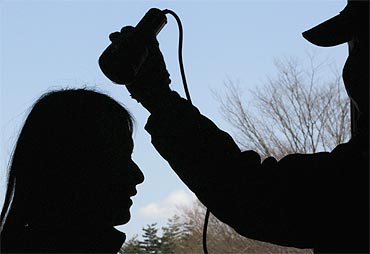
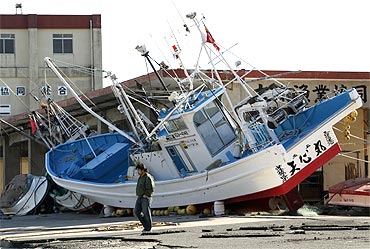
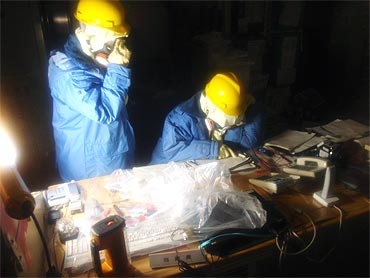
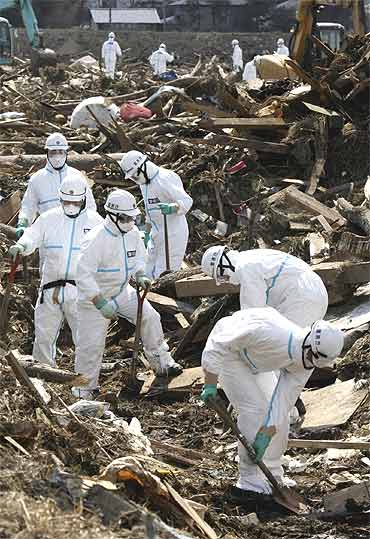
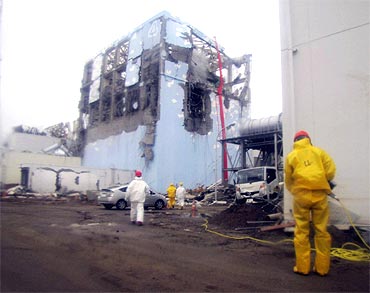
article